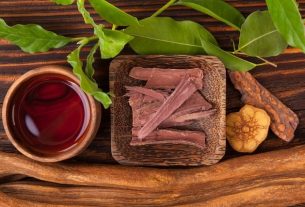Some ways to perform natural hormone replacement are to use medicinal plants such as St. Christopher’s Wort or agnocasto, which contain substances that help balance hormones and alleviate menopause symptoms, such as insomnia, hot flashes, night sweats. , anxiety or depression, for example.
Menopause is characterized by the interruption of estrogen production by the ovaries, so the use of medicinal plants can be a good option to alleviate symptoms. However, plants should only be used with medical advice, as they are not recommended for all cases, especially for women with a history of breast cancer or who are undergoing cancer treatment.
Another way to do natural replacement is through dietary supplements such as soy lecithin or soy isoflavone, whose effectiveness is safe and proven, helping women feel better during the climacteric period until the onset of menopause. See how to use soy isoflavone.

Some options for natural hormone replacement during menopause are:
1. St. Christopher’s Wort (Cimicifuga racemosa)
St. Christopher’s wort has flavonoids, glycosides, tannins and volatile oils, with an action similar to serotonin reuptake inhibitor antidepressants, such as fluoxetine or sertraline, for example, which are generally medicines recommended by a doctor to help alleviate pain. menopause symptoms.
Therefore, St. Christopher’s wort is a natural option for relieving menopause symptoms such as hot flashes, excessive sweating, anxiety, mood changes or insomnia.
How to use: St. Christopher’s herb can be used in the form of tea. To do this, add 1 tablespoon of dry leaves of the herb to 180 mL of boiling water. Let it rest for 3 minutes, strain and drink warm. Another way to use St. Christopher’s wort is in the form of tablets, which can be purchased at pharmacies or drugstores. Find out how to use St. Christopher’s wort tablets.
Possible side effects: The use of the plant in amounts recommended by the doctor is not associated with side effects. However, if used in large quantities and for a long period of time, it may result in liver damage. In the case of the St. Christopher’s wort tablet, possible side effects are diarrhea, itching, increased body weight and redness of the skin, for example.
2. Agnocasto (The chaste lamb’s vine)
Agnocasto is rich in flavonoids, essential oils, diterpenes and glycosides, which have an action on the female hormones LH and FSH, helping to reestablish hormonal balance, and alleviate menopause symptoms such as mood changes or insomnia, making it a good therapy option. natural hormone replacement.
How to use: agnocasto can be used as a tea, adding 1 teaspoon of agnocasto fruits to 300 mL of water and boiling for 3 to 4 minutes. Cover and let rest for 10 minutes. Strain and drink up to 2 cups per day. Furthermore, agnocasto can be used in the form of capsules or tablets sold in pharmacies, drugstores or compounding pharmacies. Find out how to use agnocasto capsules and tablets.
Possible side effects: The side effects of agnocasto appear when this plant is consumed very frequently and in quantities greater than those recommended by the doctor, which may cause headaches, allergies, hair loss, itching, nausea, vomiting and dry mouth.
3. Agripalma (Leonurus cardiac)
Agripalma has alkaloids, sterols and flavonoids that help balance female hormones, making it a natural hormone replacement option during menopause, helping to alleviate symptoms such as anxiety, heart palpitations or insomnia, for example.
This plant should not be used by women who use antipsychotic or non-steroidal anti-inflammatory drugs.
How to use: agripalma can be used in the form of tea. To do this, you must place 2 tablespoons of dry herb in a cup of boiling water and let it rest for 5 minutes, then strain and drink a cup in the morning and a cup at night.
Possible side effects: when used in large quantities, agripalma can cause diarrhea, drowsiness, changes in blood pressure, contraction of the uterus and uterine bleeding.
4. St. John’s Wort (Hypericum perforatum)
St. John’s wort, also known as St. John’s wort, is a medicinal plant rich in hypericin and hyperforin, with an antidepressant effect, as well as flavonols, biflavones and naphthodianthrones, which help to calm and improve menopausal symptoms such as depression and heat waves.
This plant should not be used by women who are using antidepressant medications such as sertraline, paroxetine or nefazodone, for example.
How to use: St. John’s wort can be used in the form of a tincture, capsules or as a tea prepared with the dried plant. To prepare the tea, place 1 teaspoon (2 to 3g) of dry St. John’s wort in 250 mL of boiling water and let it rest for 5 to 10 minutes. Then strain, let cool and drink 2 to 3 times a day, after meals.
Possible side effects: frequent consumption of St. John’s wort can have the side effects of stomach pain, allergies and agitation, for example.
5. Lion’s foot (Alchemilla vulgaris)
Dandelion is a plant that helps stop heavy menstruation, which is common for many women during the climacteric period, and can be combined with other plants such as Chinese Angelica (Dong quai) and Black Cohosh for a more effective effect. fast.
How to use: you can use dandelion foot in the form of tea by adding 1 tablespoon of dried dandelion foot leaves to 180 mL of boiling water. Strain after 5 minutes and drink warm.
6. Siberian ginseng (Eleutherococcus senticosus)
Siberian Ginseng is rich in eleutherosides, with antidepressant action, helping to improve mood and increase libido. Furthermore, this plant helps women adapt to the hormonal changes of menopause, reducing stress and increasing energy.
This plant should not be used by women who have high blood pressure, rheumatoid arthritis, Chron’s disease, heart or mental illnesses.
How to use: To use Siberian ginseng, you can prepare the tea by boiling 1 cm of the root in 200 mL of water. Strain after 5 minutes and drink warm.
Possible side effects: The use of Siberian ginseng is not associated with side effects, but in some cases, especially when used in large quantities, there may be vaginal bleeding, dizziness and blood pressure dysregulation.
7. Blackberry (Morus Nigra L.)
Black mulberry leaves help combat menopausal symptoms, especially hot flashes, because they contain phytoestrogens that help regulate hormonal levels in the bloodstream.
Furthermore, this plant helps improve memory, energy, mental health and sleep quality, making it a good option for natural hormone replacement during menopause.
Blackberry should not be used by women who have gastrointestinal problems, such as gastritis or ulcers, hyperthyroidism, anxiety, insomnia, cardiovascular or kidney diseases.
How to use: Black mulberry leaves can be used as tea. To prepare, boil 5 mulberry leaves in 500 mL of water. Strain after 5 minutes and drink warm.
Possible side effects: The main side effect related to blackberries is diarrhea, especially when consumed in excess.
8. Salva (Sage officinalis)
Sage is a medicinal plant that has sweat-inhibiting properties, and is especially recommended to combat hot flashes and night sweats during menopause because it helps correct hormonal levels, being effective and well tolerated by the body.
How to use: Sage can be used as a tea or tincture. To prepare the tea, add 10 g of dried sage leaves to 1 liter of boiling water. Strain after 10 minutes and drink 1 cup of warm tea up to 3 times a day.
Possible side effects: When sage is consumed in large quantities, some adverse effects may occur, such as increased heart rate, nausea and excessive heat, for example.

Sign up for our newsletter and stay up to date with exclusive news
that can transform your routine!
Warning: Undefined array key "title" in /home/storelat/public_html/wp-content/plugins/link-whisper-premium/templates/frontend/related-posts.php on line 12
Warning: Undefined array key "title_tag" in /home/storelat/public_html/wp-content/plugins/link-whisper-premium/templates/frontend/related-posts.php on line 13



